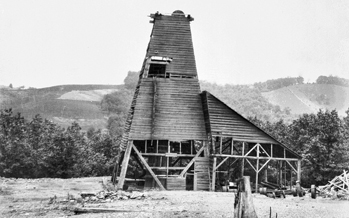Ore Knob Copper Mine
The Ore Knob Copper Mine in Ashe County was first conceived in the spring of 1854, when John Mason Lillard of Decatur, Meigs County, Tenn., channeled his resources into the organization of the Meigs County & Virginia Mining Company and the Decatur Mining Company. Lillard managed the original opening of the Ore Knob Copper Mine in 1855, when "four shafts were sunk on the property to depths of 90, 40, 30 and 40 feet and enough ore that assayed 19 percent copper was mined to make a profit of $9,400." But the distance of 63 miles over "poor mountain roads" to the nearest railroad prevented the mine from being profitable, and it was closed in 1856.
S. S. and J. E. Clayton of Baltimore reopened the mine in 1873, and that July "about 1,400 tons of ore" were raised, "averaging more than 25 percent of copper." Other periods of operation included 1896, 1913, 1917-18, 1927, 1942-43, and 1953-62, when the mine was "completely worked out" and abandoned.
In January 1982 two bodies were found in the abandoned Ore Knob Copper Mine; Johnny Sands, known as the "Nashville Flame," wrote a popular ballad about the incident. The large, gaping entrance to the mine remains a forbidding reminder of the dangers-both physical and financial-of mining.
References:
Eben E. Olcott, "The Ore Knob Copper Mine and Reduction Works, Ashe County, N.C.," American Institute of Mining Engineers Transactions 3 (1874).
Thomas J. Schoenbaum, The New River Controversy (1979).
Jasper Leonidas Stuckey, North Carolina: Its Geology and Mineral Resources (1965).
1 January 2006 | Lillard, Stewart
